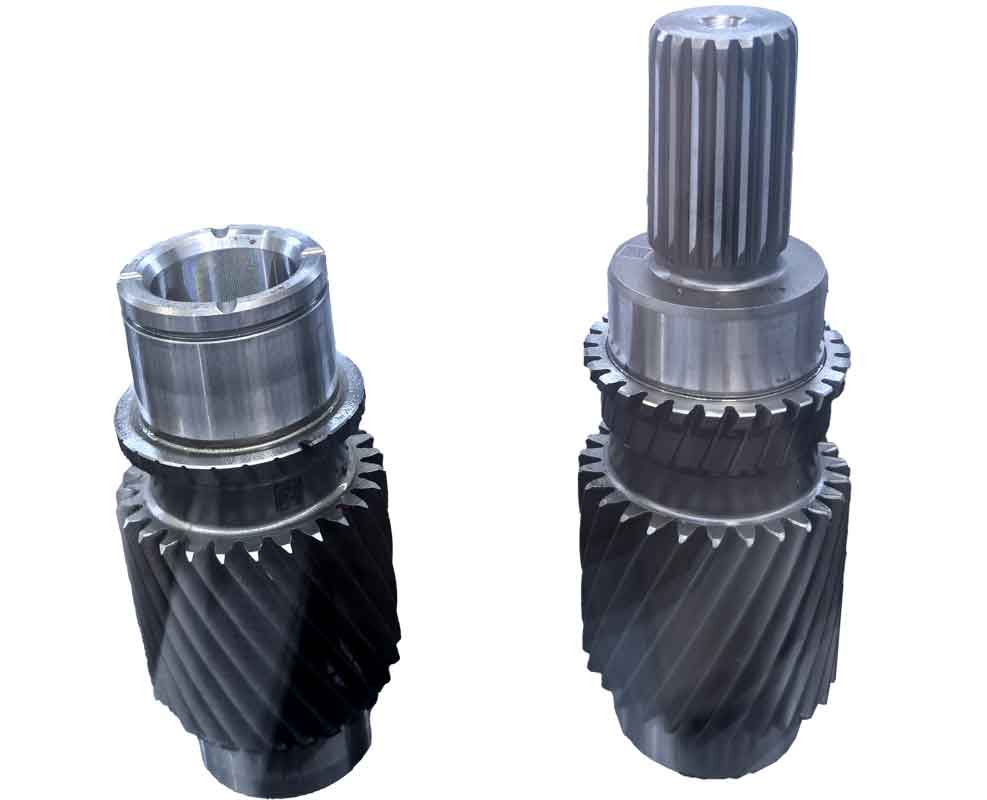This study investigates the gear cutting mechanisms of equal-high spiral bevel gears, focusing on simulation-based optimization to enhance machining precision. These gears are critical transmission components in aerospace, automotive, and heavy machinery due to their superior meshing stability, high load capacity, and reduced noise. However, achieving high-precision surfaces remains challenging due to complex tool deformation, assembly errors, and suboptimal machining parameters. We address this through finite element simulation and genetic algorithm optimization, validated experimentally.

1. Machining Principle Analysis
The meshing principle for equal-high spiral bevel gears is derived using conjugate surface theory and coordinate transformations. The meshing equation is established as:
$$ \vec{v_{12}} \cdot \vec{n} = 0 $$
where \(\vec{v_{12}}\) is the relative velocity vector at the contact point, and \(\vec{n}\) is the common normal vector. The tooth surface generation via face hobbing follows an extended epicycloidal trajectory. The cutter surface equation for a blade in the generating plane is expressed as:
$$ \vec{r_b} = \vec{r_a} + C \vec{h’_1} $$
where \(\vec{r_a}\) denotes the position vector from the cradle center to the cutter tip, \(C\) is the radial distance adjustment, and \(\vec{h’_1}\) is the unit vector after rotation \(\theta\). Key parameters influencing gear cutting accuracy include radial blade position \(E_b\), axial offset \(R_b\), and pressure angle \(\epsilon\).
2. Milling Cutter Head Structural Optimization
We optimized the blade clamping mechanism to minimize positional errors during gear cutting. Traditional single-screw designs caused blade displacement under cutting forces. Our triple-screw system (Figure 1 schematic) incorporates:
- Pre-tightening screws with spring-loaded balls for initial fixation.
- Locking screws for rigid final clamping.
Mathematically, the resultant clamping force \(F_c\) is:
$$ F_c = F_p + F_l $$
where \(F_p\) is the pre-tightening force and \(F_l\) is the locking force. Testing confirmed reduced blade displacement below 2 μm, enhancing profile accuracy. Key cutter parameters are summarized below:
| Parameter | Symbol | Value (mm) |
|---|---|---|
| Nominal Cutting Radius | \(r_G\) | 152.4 |
| Blade Projection (Inner) | \(r_I\) | 32.5 |
| Blade Projection (Outer) | \(r_A\) | 28.7 |
| Radial Distance (Outer) | \(Eb_{MA}\) | 121.8 |
3. Gear Cutting Simulation
Finite element analysis in ABAQUS simulated the gear cutting process. A simplified blade model and gear blank were used (Figure 2). The Johnson-Cook constitutive model and damage criterion governed material behavior:
$$ \sigma = \left[ A + B \left( \epsilon_p^n \right) \right] \left[ 1 + C \ln \left( \frac{\dot{\epsilon}}{\dot{\epsilon_0}} \right) \right] \left[ 1 – \left( \frac{T – T_{\text{room}}}{T_{\text{melt}} – T_{\text{room}}} \right)^m \right] $$
where \(A\), \(B\), \(n\), \(C\), and \(m\) are material constants for 45 steel. Single-factor simulations analyzed cutting force (\(F\)) and temperature (\(T\)) variations:
| Parameter | Range | \(F\) Change | \(T\) Change |
|---|---|---|---|
| Cutting Speed \(v\) (m/min) | 150–240 | −12.3% | +62.5% |
| Depth of Cut \(a_p\) (mm) | 1.0–2.5 | +41.8% | +18.7% |
| Feed \(f_z\) (mm/rev) | 0.1–0.4 | +27.5% | +9.6% |
Results showed \(a_p\) most significantly impacts forces, while \(v\) dominates temperature (Figure 3). Peak temperatures exceeded 620°C at high speeds, accelerating tool wear.
4. Parameter Optimization via Genetic Algorithm
A multi-objective genetic algorithm minimized \(F\) and \(T\) during gear cutting. Regression models from orthogonal simulations (\(L_9(3^3)\) matrix) were:
$$ F = 8.63 \cdot n^{-0.6382} \cdot f_z^{0.4073} \cdot a_p^{0.0516} $$
$$ T = 7.59 \cdot n^{0.7080} \cdot f_z^{0.5013} \cdot a_p^{0.0026} $$
Optimization constraints included:
$$ \begin{cases}
150 \leq v \leq 240 \text{m/min} \\
0.1 \leq f_z \leq 0.4 \text{mm/rev} \\
1.0 \leq a_p \leq 3.0 \text{mm} \\
F \cdot v / 1000 \leq \eta \cdot P_{\text{max}}
\end{cases} $$
After 125 generations (population: 130, crossover: 0.8), optimal parameters were:
| Parameter | Pre-Optimization | Optimized | Reduction |
|---|---|---|---|
| Spindle Speed \(n\) (rpm) | 395.7 | 316.2 | 20.1% |
| Depth of Cut \(a_p\) (mm) | 2.8 | 1.3 | 53.6% |
| Feed \(f_z\) (mm/rev) | 0.74 | 0.12 | 83.8% |
5. Machining Validation
Blades were ground on a Gleason 300-CG machine and assembled using the triple-screw clamping. Gear cutting tests on a Gleason 175HC with optimized parameters yielded:
| Precision Metric | Conventional | Optimized | Improvement |
|---|---|---|---|
| Concave Tooth Profile (Grade) | 4.5 | 3.6 | 20.0% |
| Convex Tooth Profile (Grade) | 5.3 | 4.2 | 20.8% |
| Runout Error (Grade) | 2.8 | 2.1 | 25.0% |
Klingelnberg P40 measurements confirmed enhanced surface quality and reduced noise, validating the optimization for high-precision gear cutting.
6. Conclusion
We established a complete framework for optimizing equal-high spiral bevel gear cutting:
- Meshing and cutter surface equations accurately model tooth generation.
- The triple-screw clamp reduces blade displacement to ≤2 μm.
- Finite element analysis quantifies \(a_p\) as the dominant force factor (+41.8%) and \(v\) as the primary temperature driver (+62.5%).
- Genetic algorithms yield parameters reducing cutting forces by 24.7% and temperatures by 18.3%.
- Experimental gear grades improved by 20–25%, demonstrating the method’s industrial viability.
Future work will integrate thermo-mechanical wear models to further extend tool life in precision gear cutting applications.
